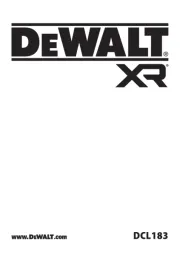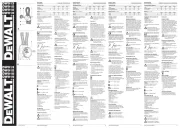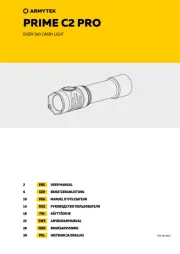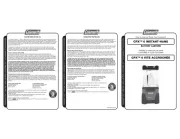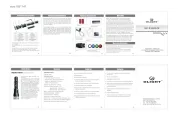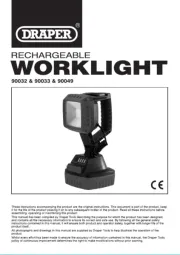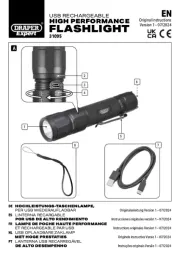IF YOU HAVE ANY QUESTIONS OR COMMENTS ABOUT THIS OR ANY DEWALT TOOL,
CALL US TOLL FREE AT: 1-800-4-DEWALT (1-800-433-9258)
Important Safety Instructions
WARNING! When using DC021 and DC022 worklight/chargers, basic
precautions should always be followed, including the following:
a. Read all the instructions before using the DC021 and DC022 worklight/chargers.
b. To reduce the risk of injury, close supervision is necessary when a worklight/charger is
used near children.
c. Do not contact moving parts.
d. Only use attachments recommended or sold by the manufacturer.
e. Do not use outdoors.
f. To disconnect, turn all controls to the off (“O”) position, then remove plug from outlet.
g. Do not unplug by pulling on cord. To unplug, grasp the plug, not the cord.
h. Unplug from outlet when not in use and before servicing or cleaning.
i. Do not operate any worklight/charger with a damaged cord or plug, or after the
worklight/charger malfunctions or is dropped or damaged in any manner. Return work-
light/charger to the nearest authorized service facility for examination, repair, or electrical
or mechanical adjustment.
j. To reduce the risk of electrical shock, do not put worklight/charger in water or other liquid.
Do not place or store worklight/charger where it can fall or be pulled into a tub or sink.
k. Use only the charger supplied by the manufacturer to recharge.
l. Always unplug before replacing the bulb. Replace bulb with same type rated 38 Watts.
m. Connect to a properly grounded outlet. Refer to Grounding Instructions.
SAVE THESE INSTRUCTIONS
Safety Rules for Worklight/Chargers
WARNING: Burn hazard. Do not operate flashlight or charger near flammable liquids or in
gaseous or explosive atmospheres. Internal sparks may ignite fumes causing personal injury.
WARNING: Shock hazard. Remove battery pack before replacing the fluorescent bulb.
• Vision may be impaired when looking directly into fluorescent light.
• Do not expose light or charger to wet or damp areas. Do not expose light or charger to rain
or snow.
• Do not wash light or charger with water or allow water to get inside light or charger. Do not
submerge light in water at any time.
• Do not operate without lens cover assembly attached.
• Before using battery and charger, read all instructions and cautionary markings on charger,
battery pack, and product using battery pack.
DANGER: Electrocution hazard. 120 volts are present at charging terminals. Do not probe
with conductive objects. Electric shock or electrocution may result.
WARNING: Shock hazard. Do not allow any liquid to get inside worklight/charger. Electric
shock may result.
CAUTION: Burn hazard. To reduce the risk of injury, charge only DEWALT rechargeable
batteries. Other types of batteries may burst causing personal injury and damage.
CAUTION: Under certain conditions, with the worklight/charger plugged in to the power
supply, the exposed charging contacts inside the charger can be shorted by foreign material.
Foreign materials of a conductive nature such as, but not limited to, steel wool, aluminum foil, or
any buildup of metallic particles should be kept away from charger cavities. Always unplug the
charger from the power supply when there is no battery pack in the cavity. Unplug
worklight/charger before attempting to clean.
•DO NOT attempt to charge the battery pack with any chargers other than the ones in this
manual. The worklight/charger and battery pack are specifically designed to work together.
•These worklight/chargers are not intended for any uses other than charging DEWALT
rechargeable batteries. Any other uses may result in risk of fire, electric shock or
electrocution.
•Do not expose worklight/charger to rain or snow. The worklight/charger is intended
for household and commercial use.
•Pull by plug rather than cord when disconnecting worklight/charger. This will reduce risk
of damage to electric plug and cord.
•Make sure cord is located so that it will not be stepped on, tripped over, or otherwise
subjected to damage or stress.
•Do not use an extension cord unless it is absolutely necessary. Use of an improper
extension cord could result in risk of fire, electric shock, or electrocution.
•An extension cord must have adequate wire size (AWG or American Wire Gauge) for
safety. The smaller the gauge number of the wire, the greater the capacity of the cable, that is
16 gauge has more capacity than 18 gauge. When using more than one extension to make up
the total length, be sure each individual extension contains at least the minimum wire size.
•Do not place any object on top of worklight/charger or place the worklight/charger on a
soft surface that might block the ventilation slots and result in excessive internal heat.
Place the worklight/charger in a position away from any heat source.
•Do not operate worklight/charger with a damaged cord or plug — have them replaced
immediately.
•Do not operate the worklight/charger if it has received a sharp blow, been dropped, or
otherwise damaged in any way. Take it to an authorized service center.
•Do not disassemble worklight/charger. Take it to an authorized service center when
service or repair is required. Incorrect reassembly may result in a risk of electric shock,
electrocution or fire.
•Disconnect the worklight/charger from the outlet before attempting any cleaning. This
will reduce the risk of electric shock. Removing the battery pack will not reduce this risk.
•This worklight/charger is designed to operate on 120 Volts, 60 Hz AC. It also operates on
direct current (DC) through a fully charged battery pack. Do not use any other voltage.
CAUTION: Burn hazard. To reduce the risk of injury, charge only DEWALT batteries. Other
types of batteries may burst causing personal injury and damage.
• The label on your worklight/charger may include the following symbols. The symbols and
their definitions are as follows:
V ..................volts A ....................amperes
Hz ................hertz W ....................watts
min ..............minutes ..................alternating current (AC)
............direct current (dc) no....................no load speed
................Class I Construction ....................earthing terminal
....................(grounded) ....................safety alert symbol
..................Class II Construction …/min ............revolutions or reciprocation
.................... ........................(double insulated) per minute
F ..................fahrenheit temp. BPM................beats per minute
C..................celsius temp.
SAVE THESE INSTRUCTIONS
Grounding Instructions
The DC021 and DC022 worklight/chargers must be grounded. In the event of malfunction or
breakdown, grounding provides a path of least resistance for electric current to reduce the risk
of electric shock. The worklight/chargers are equipped with a cord having an equipment-
grounding conductor and a grounding plug. The plug must be plugged into an appropriate
outlet that is properly installed and grounded in accordance with all local codes and ordinances.
DANGER: Improper connection of the equipment grounding conduct or can result in a risk
of electric shock. The conductor with insulation having an outer surface that is green with or
without yellow stripes is the equipment grounding conductor. If repair or replacement of the cord
or plug is necessary, do not connect the equipment-grounding conductor to a live terminal.
Check with a qualifed electrician or serviceman if the grounding instructions are not completely
understood, or if in doubt as to whether the worklight/charger is properly grounded. Do not
modify the plug provided with the worklight/charger – if it will not fit the outlet, have a proper
outlet installed by a qualifed electrician.
FOR GROUNDED, CORD-CONNECTED WORKLIGHT/CHARGERS RATED LESS THAN
15A AND INTENDED FOR USE ON A NOMINAL 120V SUPPLY CIRCUIT
The worklight/charger is for use on a nominal 120V circuit, and has a grounding plug that looks
like the plug illustrated in sketch a. A temporary adaptor, which looks like the adaptor illustrated
in sketches b and c, may be used to connect this plug to a 2-pole receptacle as shown in sketch
b if a properly grounded outlet is not available. The temporary adaptor should be used only until
a properly grounded outlet can be installed by a qualifed electrician. The green colored rigid ear,
lug, and the like, extending from the adaptor must be connected to a permanent ground such as
a properly grounded outlet box cover. Whenever the adaptor is used, it must be held in place by
the metal screw.
Ground Fault Circuit Interrupt (GFCI)
On the DC022, all 15 Amp receptacles are protected by a ground fault circuit interrupter (GFCI).
The GFCI shuts off the power to the receptacle when it senses small imbalances caused by
current leakage to ground.
A Ground Fault Circuit Interrupter (GFCI) is provided for use with the worklight/charger.
Receptacles are available having built in GFCI protection and may be used for an added
measure of safety. When using an extension cord, a GFCI should be installed to the power
supply before the extension cord.
To Test A GFCI
WARNING: To reduce the risk of injury, the GFCI should be tested for proper operation every
time the worklight/charger is used.
DC022 ONLY (FIG. 3, 4)
1. Plug the DC022 power cord into power outlet. The LED indicator on top of the charger
housing should turn green (L).
2. Press the test button (N) on the GFCI outlets on the side of the worklight. The green LED
indicator should disappear.
3. Press reset button (M) for use. Do not use if above test fails.
Use of Extension Cords
Only use grounded extension cords that are rated for outdoor use and equipment with a third-
wire ground.
When a long extension cord is used to connect a worklight/charger or tool to a generator, a
voltage drop occurs. The longer the cord, the greater the voltage drop. This results in less volt-
age being supplied to the worklight/charger or tool and increases the amount of current (amp)
draw or reduces performance. A heavier cord with a larger wire size will reduce the voltage drop.
Be sure to choose a cord that will supply enough voltage to operate your tool or worklight/charg-
er. The tables below indicate appropriate gauge for extension cords and the voltage drop caused
by the use of extension cords, given different electrical loads.
WARNING: Keep electrical cords in good condition. Do not use worn, bare, or frayed cords
because they can cause electrical shock.
WARNING: Operating equipment at low voltage can cause it to overheat. Using an
excessively long extension cord can cause the cord to overheat.
MINIMUM GAUGE FOR EXTENSION CORD SETS
Volts Total Length of Cord in Feet
120V 0–25 26–50 51–100 101–150
240V 0–50 51–100 101–200 201–300
Ampere Rating AWG
0–10 (A) 16 16 14 14
10–13 (A) 16 16 14 12
13–16 (A) 14 14 12 12
16–25 (A) 12 12 12 10
25–30 (A) 10 10 10 Not Recommended
Extension
Cord Amp Voltage Drop
Length Load 16 AWG 14 AWG 12 AWG 10 AWG
10A 2.0 1.3 0.8 0.5
25 15A 3.0 1.9 1.2 0.8
Foot 20A 4.0 2.5 1.6 1.1
30A 6.0 3.8 2.3 1.6
10A 4.0 2.5 1.6 1.1
50 15A 6.0 3.8 2.3 1.6
Foot 20A 8.0 5.0 3.1 2.1
30A 12.0 7.5 4.7 3.2
a b c d
grounding pin
grounded
outlet
box grounding
means
grounding pin
adapter
INSTRUCTION MANUAL
GUIDE D'UTILISATION
MANUAL DE INSTRUCCIONES
DC021, DC022
Heavy-Duty Cordless/Corded Worklight/1 hour charger
Lampe de travail sans fil et avec fil/chargeur une heure de service intensif
Cargador de 1 hora/luz de trabajo con cable/inalámbrico para trabajo pesado
INSTRUCTIVO DE OPERACIÓN, CENTROS DE SERVICIO Y
PÓLIZA DE GARANTÍA. ADVERTENCIA: LÉASE ESTE
INSTRUCTIVO ANTES DE USAR EL PRODUCTO.
DEWALT Industrial Tool Co., 701 East Joppa Road, Baltimore, MD 21286
(AUG06) Form No. 646937-00 DC021, DC022 Copyright © 2006 DEWALT
The following are trademarks for one or more DEWALT power tools: the yellow and black color
scheme; the “D” shaped air intake grill; the array of pyramids on the handgrip; the kit box
configuration; and the array of lozenge-shaped humps on the surface of the tool.
If you have questions or comments, contact us.
Pour toute question ou tout commentaire, nous contacter.
Si tiene dudas o comentarios, contáctenos.
1-800-4-DEWALT • www.dewalt.com
Definitions: Safety Guidelines
The definitions below describe the level of severity for each signal word. Please read the
manual and pay attention to these symbols.
DANGER: willIndicates an imminently hazardous situation which, if not avoided, result
in death or serious injury.
WARNING: couldIndicates a potentially hazardous situation which, if not avoided,
result in death or serious injury.
CAUTION: Indicates a potentially hazardous situation which, if not avoided, may result
in minor or moderate injury.
CAUTION: Used without the safety alert symbol indicates a potentially hazardous situation
which, if not avoided, result in may property damage.
